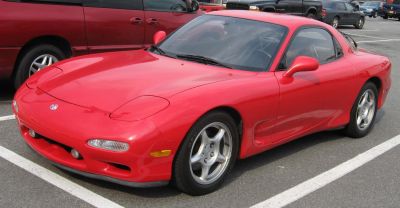 1999 Mazda RX 7 IV Dimensions, Size & Specs
1999 Mazda RX 7 IV Dimensions, Size & SpecsMeasurements of the 1999 Mazda RX 7 IV, engineered for optimal performance and comfort
| Dimensions | |
|---|---|
| Length: | 4285 mm168.7 in14.1 ft |
| Width: | 1760 mm69.3 in5.8 ft |
| Height: | 1230 mm48.4 in4.0 ft |
| Weight Specifications | |
| Curb Weight: | 1240 kg2734 lbs |
| Maximal permitted Weight: | 1490 kg3285 lbs |
| Tire Specifications | |
| Rims Size: |
|
| Tire Size: |
|
The Mazda RX-7 IV, produced between 2000 and 2002, represents the fourth generation of Mazda's iconic RX-7 sports coupe. The 1999 model year RX-7 IV is distinguished by its compact and aerodynamic design, reflecting Mazda's commitment to blending performance with sleek styling. This coupe measures 4285 mm (168.7 inches) in length, which provides a balanced footprint that enhances its agile handling characteristics. Its width is 1760 mm (69.3 inches), offering a stable stance on the road, while its low height of just 1230 mm (48.4 inches) helps improve aerodynamic efficiency and gives it a sporty, aggressive profile.
Weighing in at a curb weight of 1240 kg (2734 lbs), the RX-7 IV remains relatively lightweight, which contributes to its dynamic driving experience and responsive handling. The maximum weight is rated at 1490 kg (3285 lbs), underscoring Mazda's engineering focus on keeping the car nimble yet sufficiently sturdy. The RX-7 IV rides on 16-inch rims paired with tire dimensions of 225/50 R16, providing a good balance between grip and comfort, suitable for spirited driving as well as daily usability.
As a coupe, the RX-7 IV maintains the tradition of offering a driver-focused, two-door configuration prioritizing sportiness and aesthetics. Its proportions and weight distribution reflect Mazda's design philosophy aimed at delivering a thrilling yet manageable driving experience. Enthusiasts will appreciate the RX-7 IV not only for its rotary engine technology but also for its compact and purposeful size making it stand out in the sports car segment during its production era.
Discover the standout features that make the 1999 Mazda RX 7 IV a leader in its class
Have a question? Please check our knowledgebase first.
The Mazda RX-7 IV, produced between 2000 and 2002, has a length of 4285 mm (168.7 inches), a width of 1760 mm (69.3 inches), and a height of 1230 mm (48.4 inches). These compact sporty dimensions contribute to the RX-7's agile and nimble handling characteristics, making it well-suited for performance driving and tight cornering. The size also maintains a low profile that enhances aerodynamics and visual appeal.
The curb weight of the 1999 Mazda RX-7 IV is approximately 1240 kg (2734 lbs), while the maximum allowable weight is 1490 kg (3285 lbs). The relatively low curb weight helps the RX-7 achieve impressive performance and handling by keeping the car lightweight and responsive. The maximum weight includes passengers and cargo, ensuring safe operation without compromising structural integrity or suspension performance.
The Mazda RX-7 IV comes equipped with 16-inch rims, paired with 225/50 R16 tires. These tire dimensions provide a good balance between grip, ride comfort, and responsiveness. The moderately wide 225 mm tire width enhances traction and cornering stability, while the 50 aspect ratio offers suitable sidewall height to absorb road imperfections without sacrificing handling precision, resulting in a sporty yet comfortable ride.
Yes, the Mazda RX-7 IV fits into a standard residential garage comfortably. With a length of 4285 mm (168.7 inches) and a width of 1760 mm (69.3 inches), it is compact enough for most typical garages, which often measure around 2.4 to 3 meters in width and 5 to 6 meters in length. The relatively low height of 1230 mm (48.4 inches) also poses no clearance issues in standard garage door openings, making it convenient for daily parking.
Compared to the RX-7 III (FD), the RX-7 IV is slightly larger in overall dimensions, reflecting Mazda's aim to add more interior space and comfort without sacrificing the RX-7’s sporty nature. The RX-7 III generally measured about 4265 mm (167.9 inches) in length and 1775 mm (69.9 inches) in width, so the IV gained around 20 mm (0.8 inches) in length and was a bit narrower by approximately 15 mm (0.6 inches). The height remained quite similar but was slightly reduced, enhancing its sleek profile. These subtle dimensional changes improved driver ergonomics and everyday usability while maintaining the car's famed performance.
When compared to similar sports coupes from the early 2000s like the Nissan 350Z, Toyota Supra Mk4, and Mitsubishi Eclipse, the Mazda RX-7 IV is relatively compact and lightweight. For instance, the Nissan 350Z is longer at around 4270 mm (168 inches) but wider at about 1815 mm (71.5 inches), while the Supra Mk4 is generally longer and heavier. The RX-7 IV's smaller footprint and lighter weight of just 1240 kg (2734 lbs) make it specifically agile and nimble on the road, favoring precision driving over sheer size or power, appealing to enthusiasts valuing balance between dimensions and performance.
The Mazda RX-7 IV has a wheelbase measuring approximately 2500 mm (98.4 inches). This relatively short wheelbase contributes to the car’s agile handling, allowing for quick directional changes and improving cornering responsiveness. A shorter wheelbase typically results in a more dynamic driving experience but may slightly reduce straight-line stability at high speeds. Mazda’s engineering strikes a balance so that the RX-7 IV offers both nimble maneuverability and sufficient stability for spirited driving.
As a sporty two-door coupe, the Mazda RX-7 IV prioritizes driver engagement and performance over extensive cabin or cargo space. While exact interior volume figures are limited, the dimensions support a snug two-seater layout offering a driver-focused cockpit with supportive seating. Cargo space is relatively limited compared to larger coupes or sedans, generally accommodating small luggage or daily essentials in the rear hatch area. This compact interior design aligns with the RX-7’s ethos as a lightweight, sporty vehicle designed for driving enthusiasts.
The Mazda RX-7 IV stands at a height of 1230 mm (48.4 inches), giving it a very low and sleek stance typical of sports coupes, which aids aerodynamic efficiency and a lowered center of gravity for enhanced handling. Ground clearance is modest, designed to balance sporty appearance with practical everyday usability. This height may demand some caution over steep driveways or uneven surfaces but generally poses no major issues in typical urban and suburban driving scenarios, making it suitable for daily use with sporty flair.
The overall compact exterior dimensions of the Mazda RX-7 IV, including its 4285 mm (168.7 inches) length and 1760 mm (69.3 inches) width, make it easier to park and maneuver in tight urban environments compared to larger sports cars of its era. Its low height at 1230 mm (48.4 inches) and turning radius are optimized for responsive handling and tight cornering, enhancing the driver's ability to negotiate narrow spaces and city streets. These size advantages allow the RX-7 IV to excel both on the track and in everyday driving conditions involving parking and maneuverability.
Discover similar sized cars.

| Production: | 2009-2012 |
|---|---|
| Model Year: | 2009 |
| Length: | 4347 mm171.1 in |
| Width: | 1978 mm77.9 in |
| Height: | 1285-1306 mm50.6-51.4 in |

| Production: | 2005-2009 |
|---|---|
| Model Year: | 2006 |
| Length: | 4341 mm170.9 in |
| Width: | 1978 mm77.9 in |
| Height: | 1305 mm51.4 in |

| Production: | 1992-2000 |
|---|---|
| Model Year: | 1992 |
| Length: | 4285-4295 mm168.7-169.1 in |
| Width: | 1760 mm69.3 in |
| Height: | 1230 mm48.4 in |
